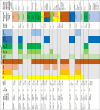Assessment of GFR in Patients with Cancer: A Statement from the American Society of Onco-Nephrology
- PMID: 38848131
- PMCID: PMC11321742
- DOI: 10.2215/CJN.0000000000000508
Assessment of GFR in Patients with Cancer: A Statement from the American Society of Onco-Nephrology
Abstract
Accurate assessment of GFR is crucial to guiding drug eligibility, dosing of systemic therapy, and minimizing the risks of both undertreatment and toxicity in patients with cancer. Up to 32% of patients with cancer have baseline CKD, and both malignancy and treatment may cause kidney injury and subsequent CKD. To date, there has been lack of guidance to standardize approaches to GFR estimation in the cancer population. In this two-part statement from the American Society of Onco-Nephrology, we present key messages for estimation of GFR in patients with cancer, including the choice of GFR estimating equation, use of race and body surface area adjustment, and anticancer drug dose-adjustment in the setting of CKD. These key messages are based on a systematic review of studies assessing GFR estimating equations using serum creatinine and cystatin C in patients with cancer, against a measured GFR comparator. The preponderance of current data involving validated GFR estimating equations involves the CKD Epidemiology Collaboration (CKD-EPI) equations, with 2508 patients in whom CKD-EPI using serum creatinine and cystatin C was assessed (eight studies) and 15,349 in whom CKD-EPI with serum creatinine was assessed (22 studies). The former may have improved performance metrics and be less susceptible to shortfalls of eGFR using serum creatinine alone. Since included studies were moderate quality or lower, the American Society of Onco-Nephrology Position Committee rated the certainty of evidence as low. Additional studies are needed to assess the accuracy of other validated eGFR equations in patients with cancer. Given the importance of accurate and timely eGFR assessment, we advocate for the use of validated GFR estimating equations incorporating both serum creatinine and cystatin C in patients with cancer. Measurement of GFR via exogenous filtration markers should be considered in patients with cancer for whom eGFR results in borderline eligibility for therapies or clinical trials.
Copyright © 2024 by the American Society of Nephrology.
Conflict of interest statement
Disclosure forms, as provided by each author, are available with the online version of the article at
Figures


References
Publication types
MeSH terms
Substances
Grants and funding
LinkOut - more resources
Full Text Sources
Medical
Research Materials
Miscellaneous

